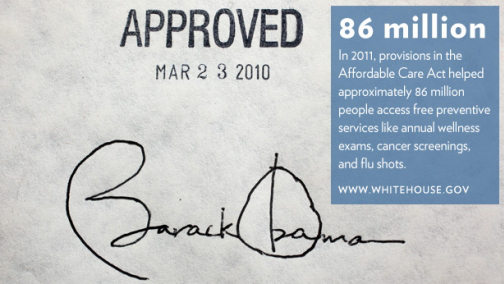

The March 31st deadline for people to sign up for insurance coverage under the Affordable Care Act (ACA) has come and gone. Media coverage prior to the deadline reached a feverish pitch and no doubt helped the Obama administration to exceed its revised target of 6 million people enrolled under the health insurance exchanges. But it is foolhardy to believe that simply covering more people to receive care in a dysfunctional, acute-care-oriented system will promote the nation’s health and reduce health care costs. Perhaps now we can shift the national conversation to the many components of the ACA that can change how and where we can promote the health of people where they live, work, and play. Health promotion–not insurance penalties–is what the health care system needs more of.
Most people are unaware of the law’s provisions that can change what kind of health care— is delivered–and where and how. For example, “Independence At Home” is an initiative built into the ACA that expands capitated programs for all-inclusive care–physical, psychological, social, and functional–of older adults provided by physician- or nurse-led interprofessional primary care teams. These programs already exist and have been shown to be successful in keeping older adults living in their own homes, out of nursing homes and hospitals, and engaged in health and social activities, with improved quality of life and lower costs.
At the other end of the life spectrum, the ACA expands funding for home visitation programs for high-risk mothers and their newborns, based largely upon the Nurse-Family Partnership (NFP). The NFP has decades of research documenting the short- and long-term benefits to the physical, psychological, and social health of participating women and their children, with a significant return on investment–a $5.70 return for every dollar invested in a high-risk family.
Demonstration projects are already under way to expand models of transitional care that help patients and their family caregivers better manage their acute and chronic illnesses in ways that reduce 30-day hospital readmissions. The focus on reducing the rate of readmissions has already moved most hospitals to test new ways of partnering with community-based health care organizations to smooth the transition from hospital to home.
The ACA also includes grants for employee wellness programs. Initiatives such as Wise Health Decisions, a nurse-led employee wellness program in Indiana that contracts with employers to provide on-site health promotion and coaching services, have demonstrated improved health indicators while reducing employers’ spending on health care. The investment in health promotion enables health risk assessments, early detection of health problems, and helping people become more engaged in living healthier lives.
Two other elements of the ACA have great potential for promoting the health of communities: the community benefit requirement for nonprofit hospitals and the expansion of nurse-managed health centers. The former requires nonprofit hospitals to conduct a health needs assessment of a community they serve, develop a community improvement plan, and demonstrate how they are helping to implement this plan–ideally, in partnership with the local public health department and other community stakeholders. Some hospital executives view this requirement cynically as simply more paperwork to keep their nonprofit tax status. But it’s an opportunity to engage one of the most powerful employers in a community to be vested in a healthy future. We may need to put some teeth into this requirement by developing value-based payments for hospitals that can show meaningful engagement and progress on community improvement plans.
Finally, the ACA authorized nurse-managed health centers (NMHCs), but did not mandate funding them. Most NMHCs were started by schools of nursing through funding from the U.S. Health Resources and Services Administration to create clinical practices that serve the needs of vulnerable and underserved populations and to provide sites for faculty practice and clinical teaching of students. Today, there are about 150 NMHCs, some of which are federally qualified health centers. Most are served by interprofessional teams of nurses, physicians, nutritionists, social workers, and others to provide primary care and wellness services to individuals, families, and the whole community. For example, the Eleventh Street Family Health Service in North Philadelphia recognized that the leading health problems in the community it serves are obesity, diabetes, hypertension, and heart failure. In addition to individual and group health services to address these problems, the clinic organized a local farmer’s market on site and created a community garden that is tended by the neighborhood youth as ways to bring healthy eating into this community, which had no supermarket before 2011.
Meeting the “triple aim” of improving people’s experiences with health care, improving the health of the population, and reducing per capita health care costs requires more than improving access to coverage. The ACA provides opportunities to test, refine, and expand models of care that can reduce the need for acute care. But it’s only a beginning. Many of these models should be available to communities across the nation, instead of being an uncommon experience. It’s time to change the conversation away from insurance coverage and penalties and toward program investments that truly matter if we’re to become a healthier nation.
Diana J. Mason is the Rudin Professor of Nursing at Hunter College, a member of the doctoral faculty at the Graduate Center, CUNY and President of the American Academy of Nursing. Donna Nickitas is a professor of nursing at Hunter College and the executive officer of the nursing doctoral faculty at the Graduate Center, CUNY.








